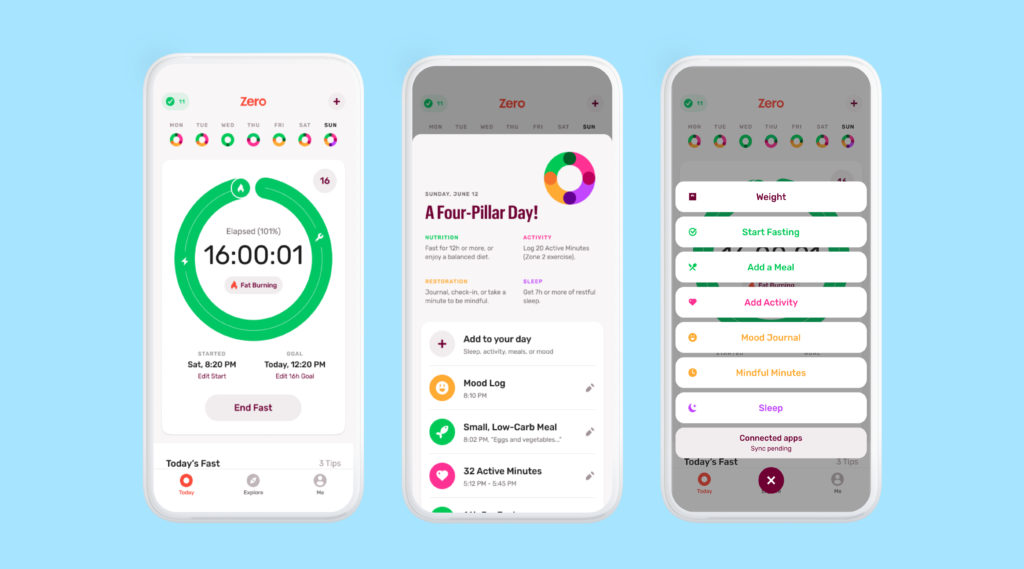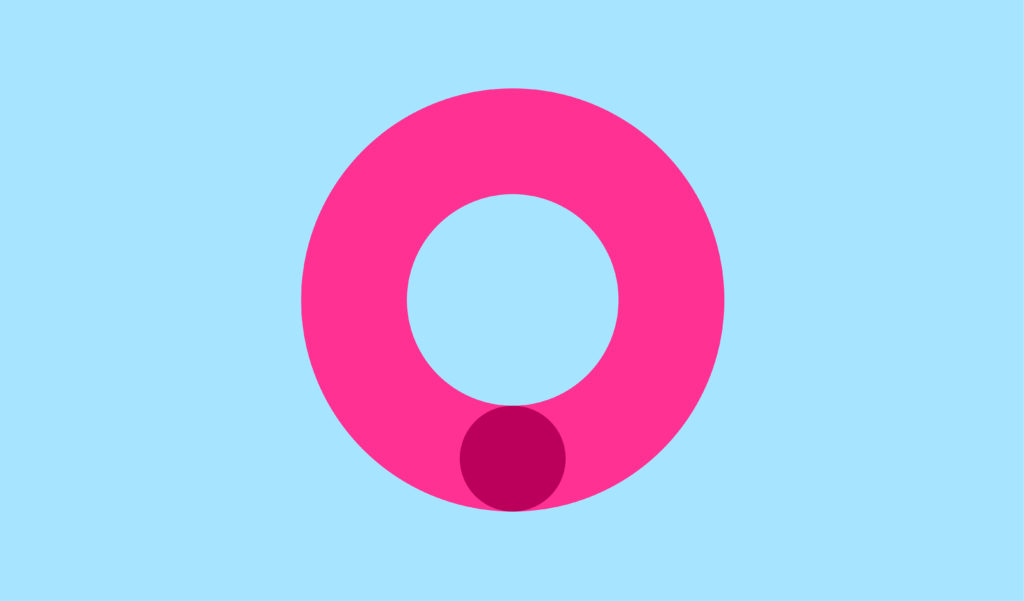Written and medically reviewed by Nicole Grant, RD
Life is full of stressors, and how we deal with them is an essential component of our overall health and well-being. The word Restoration may conjure images of fancy spas and ambitious home remodelings, but we’re here to talk about Restoration as a tool for managing stress and getting back into balance.
Because it’s seen as a “nice-to-have,” Restoration is arguably the most neglected of the Four Pillars of Health, which include Nutrition, Activity, and Sleep. But without it, you’re more susceptible to illness, weight gain, and accelerated aging.
Keep reading to discover the importance of the Restoration Pillar, get practical tips for building healthy Restoration habits, and see how Zero can guide you along the way.
How Restoration Supports Your Health Goals
Put simply, Restoration helps your body get better at managing stress. In turn, this can lower blood pressure, cortisol levels, waist circumference, and BMI — all significant factors for your health and lifespan. Most people think of restorative activities as gentle and relaxing, and they certainly can be! Yoga, breathwork, and meditation are all effective strategies for reducing stress levels. But reducing stress is only half of the Restoration equation.
In order for your body to truly increase its resilience, you need a “peak” of short-term stress followed by a “valley” of recovery. The idea is that a brief stimulus — a hormetic stressor such as a HIIT workout, ice bath, infrared sauna, or a longer fast — acts as a microdose of stress to inoculate your body’s defenses against bigger and broader stressors in the future.
The actual inoculation, however, happens during the recovery phase, as your body builds back even stronger. The key is learning to balance both the stress and the recovery elements of Restoration.
How to Start Building Healthy Restoration Habits
Restorative activities are highly individualized; what revitalizes you one day may not be as ideal the next. Therefore, it’s a good idea to have several options at your disposal.
Here are a few suggestions:
- Move your body outdoors. Research shows that exposure to green spaces curtails stress and can even ameliorate headaches.
- Turn on your favorite playlist. Listening to music can help you unwind by decreasing cortisol levels and improving your perception of stress.
- Practice deep breathing. Just a few minutes of deep breathing can aid with insomnia. Do it while you’re waiting for the shower to warm up or sitting in traffic on your commute to work.
- Try journaling or meditation. In one study, patients suffering from heart disease who practiced gratitude journaling reported feeling happier and had reduced biomarker inflammation scores.
How Zero Helps You Restore Better
The best part about embarking on a Restoration journey with Zero is that you’re not alone. In addition to a wealth of articles and videos, Zero has three important features that will help you assess your big-picture progress. Let’s get to know them!

The Loop
Visualize your journey and celebrate your wins across days, weeks, months, and years. As you log your healthy Restoration habits, like having a journaling session or taking a meditation break, you’ll see the Loop fill up with Restoration’s corresponding color, orange. To fill in all four colors and close the Loop for the day, you’ll need to complete the other Pillars of Health — more on them later.
The Habit Tracker
Build actionable, data-driven Restoration habits with the Habit Tracker. Simply tap on the “+” icon in the upper right corner of the Today tab, and watch your smart choices tell a compelling story of progress over time.
The Fasting Timer
Aside from providing an array of health benefits, like preventing chronic diseases and boosting longevity, fasting is also considered a hormetic stressor. And since we know that experiencing stress is one half of the Restoration equation, incorporating fasting into your routine is the perfect addition to your Restoration practice. With Zero’s Fasting Timer, you can track your fasts, receive custom Fasting Tips based on your unique metrics, and access Personalized Fasting Zones, which detail your body’s inner workings throughout a fast.
Pairing Restoration with the Other Pillars of Health
When you integrate healthy Restoration habits into your daily life, you’ll also eat better, move better, and sleep better. By linking these healthy habits, you’ll experience lasting, transformative changes to your well-being.
Restoration + Healthy Nutrition

To track your healthy Nutrition habits, tap the “+” icon in the upper right corner of the Today tab.
The food you eat can either help or hinder your restorative efforts. Unfortunately, the modern food environment tips the scale towards more inflammation and accelerated aging (a.k.a. inflammaging). Fortunately, there are actions you can take to balance the scale in your favor.
Cooking at home is one of the best ways to do that since it gives you full control over what goes into your meal. For instance, instead of the highly inflammatory oils (e.g., canola, vegetable, and corn oils) that are frequently used commercially, you can opt for avocado or olive oil, both of which lend to lower levels of post-meal inflammation, especially for those with metabolic syndrome. Similarly, by adding a colorful variety of fruits and vegetables to your plate, you’ll capitalize on antioxidants that counteract oxidative stress.
Tip: Don’t forget protein! Organic options like wild fish, pasture-raised poultry, eggs, legumes, and tempeh are all critical for the muscle growth and repair that happens during the recovery phase of Restoration.
Restoration + Healthy Activity

To track your healthy Activity habits, tap the “+” icon in the upper right corner of the Today tab. Using Apple Watch or another app or wearable? Connect Zero with Apple Health and we’ll automatically sync your daily progress.
Many people think of exercise as grueling, back-breaking, and impossibly sweaty. However, exercise comes in different types, durations, and intensities, all of which are important to balance your health and improve your resilience to stress.
Home-based activities such as yoga and foam rolling work well to combat stress overload. Walking in nature is another excellent choice — just 15 minutes of walking through a forest has been shown to significantly reduce cortisol levels (which, when chronically elevated, can lead to the aforementioned inflammaging).
Tip: The best form of exercise is one that you enjoy and can commit to doing regularly. Research shows that those who ascribe to a morning exercise routine have the best chances of sticking to it.
Restoration + Healthy Sleep

To track your healthy Sleep habits, tap the “+” icon in the upper right corner of the Today tab. Using Apple Watch or another app or wearable? Connect Zero with Apple Health and we’ll automatically sync your daily progress.
Sleep and Restoration go hand in hand. Your nightly shut-eye allows your body to repair cells, clear metabolic waste, and manage inflammation. While the length of your sleep is vital (7–9 hours for most people), the quality of your sleep can also greatly impact your Restoration capabilities. Specifically, the non-REM stage 3 phase of sleep, which is when your body regrows tissues and strengthens its immune system, is paramount to healthy Restoration.
As you age, sleep can become more challenging due to imbalances of melatonin and nighttime cortisol levels, which occur naturally. The later you fall asleep and the shorter your bouts of sleep, the less deep sleep you’re able to get. Consequently, it becomes even more crucial to maintain good sleep hygiene that supports consistent sleep quality.
Tip: Mindful meditation and breathwork before bed can help enhance the quality of your sleep. Also, consider putting away electronics 60–90 minutes before bed to preserve adequate melatonin levels.
Conclusion
Restorative activities like meditation, yoga, journaling, and spending time in nature can improve your physical and mental state while reducing the risk of stress-related diseases. And when you leverage your Restoration practice to build other healthy habits across Nutrition, Activity, and Sleep, you’ll be on the right path towards living better, longer.
- 4 Easy Tips to Burn Fat Faster - July 3, 2024
- Why Should We Care About Hormones? Fasting and Hormone Health - April 1, 2024
- Should You Consider a Continuous Glucose Monitor (CGM) If You’re Non-Diabetic? - March 18, 2024

